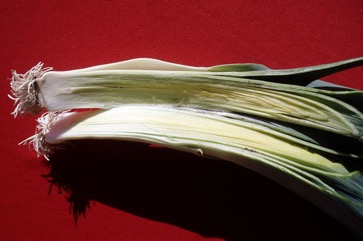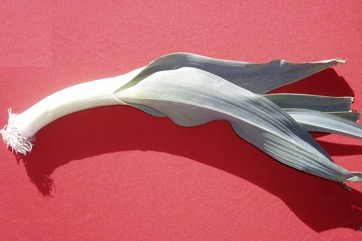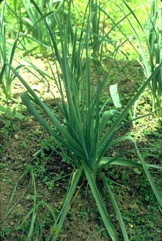Leek

A temperate plant. It does best with a day temperature below 24°C. So it is mostly over 800 m altitude in the tropics and grows up to 2600 m. It needs a fertile soil. It is very frost resistant. The soil needs to be well drained but retain moisture. It suits hardiness zones 5-10.
Also known as:
Aga, Ajo porro, Bawang prei, Bawang sayuran, Hazir, Jiu cong, Krathiam-bai, Krathiam-ton, Kuse, Kutsai, Lauch, Likisi, Look, Luk, Pirassa, Poireau, Porro, Puerro, Sibuyas-bisaya, Yabani pirasa
Synonyms
- Allium porrum L.
Edible Portion
- Flowers, Leaves, Root, Herb, Vegetable, Bulb, Sprouts
Where does Leek grow?
Found in: Africa, Albania, Argentina, Asia, Australia, Belgium, Britain, Bulgaria, Cambodia Canada, Caucasus, Central America, China, Crete, Croatia, Cuba, Cyprus, East Africa, Egypt, Europe, Fiji, France, Georgia, Greece, Haiti, India, Indonesia, Iran, Iraq, Italy, Kurdistan, Laos, Lebanon, Lithuania, Macedonia, Madagascar, Malaysia, Myanmar, Nauru, Netherlands, Niger, North Africa, North America, Pacific, Papua New Guinea, PNG, Philippines, Portugal, Romania, SE Asia, Serbia, South Africa, Southern Africa, South America, Spain, Sri Lanka, Tasmania, Thailand, Turkey, United States, Vanuatu, Vietnam, West Africa, Yugoslavia, Zimbabwe
Notes: There are about 300-700 Allium species. Most species of Allium are edible (Flora of China). All alliums are edible but they may not all be worth eating! They have also been put in the family Alliaceae.
Status: Moderately common in the highlands of Papua New Guinea. It is a commercially cultivated vegetable.
Growing Leek
Cultivation: They can be grown from seed. Seedlings can be transplanted. They are transplanted when 15-20 cm high. The base of plants or suckers are more commonly used for planting. It is difficult to save seed in the wet tropics. If plants are planted in a hole 10-15 cm deep they develop long white edible stalks. The soil should be mounded up around the base of the plant. A spacing of 15-20 cm between plants and in rows 30-36 cm apart is suitable,
Edible Uses: The whole plant is boiled except for the tops of the leaves. They can also be eaten raw. Sprouted seeds are eaten.
Production: Plants are ready for harvest after 16-20 weeks. A yield of 20 kg per 10 metres square is average.
Nutrition Info
per 100g edible portion| Edible Part | Energy (kcal) | Protein (g) | Iron (mg) | Vitamin A (ug) | Vitamin c (mg) | Zinc (mg) | % Water |
|---|---|---|---|---|---|---|---|
| Leaves | 29 | 2 | 7.5 | 1827 | 29 | - | 91 |
Leek Photos



References
Ambasta S.P. (Ed.), 2000, The Useful Plants of India. CSIR India. p 28 (As Allium porrum)
Ann. Sci. Nat. Bot. ser. 3, 8:218. 1847
Bernholt, H. et al, 2009, Plant species richness and diversity in urban and peri-urban gardens of Niamey, Niger. Agroforestry Systems 77:159-179
Bianchini, F., Corbetta, F., and Pistoia, M., 1975, Fruits of the Earth. Cassell. p 86
Bodkin, F., 1991, Encyclopedia Botanica. Cornstalk publishing, p 65 (As Allium porrum)
Bussman, R. W., et al, 2016, A comparative ethnobotany of Khevsureti, Samtskhe-Javakheti, Tusheti, Svaneti, and Racha-Lechkhumi, Republic of Georgia (Sakartvelo), Caucasus. Journal of Ethnobiology and Ethnomedicine (2016) 12:43 (As Allium porrum)
Cheifetz, A., (ed), 1999, 500 popular vegetables, herbs, fruits and nuts for Australian Gardeners. Random House p 32 (As Allium porrum)
Chen Xinqi, Liang Songyun, Xu Jiemei, Tamura M.N., Liliaceae. Flora of China. p 130 (As Allium porrum)
Chin, H. F., 1999, Malaysian Vegetables in Colour. Tropical Press. p 72
Ciftcioglu, C. G., 2015, Sustainable wild-collection of medicinal and edible plants in Lefke region of North Cyprus. Agroforest Syst. Springer
Facciola, S., 1998, Cornucopia 2: a Source Book of Edible Plants. Kampong Publications, p 5
Flora of Pakistan. www.eFloras.org (As Allium porrum)
Foo, J.T.S.(ed), 1996, A Guide to Common Vegetables. Singapore Science Foundation. p 108 (As Allium porrum)
French, B., 1986, Food Plants of Papua New Guinea, Asia Pacific Science Foundation p 125 (As Allium porrum)
Furusawa, T., et al, 2014, Interaction between forest biodiversity and people's used of forest resources in Roviana, Solomon Islands: implications for biocultural conservation under socioeconomic changes. Journal of Ethnobiology and Ethnomedicine, 10:10 (As Allium porrum)
Grubben, G. J. H. and Denton, O. A. (eds), 2004, Plant Resources of Tropical Africa 2. Vegetables. PROTA, Wageningen, Netherlands. p 41
Hadfield, J., 2001, The A-Z of Vegetable Gardening in South Africa. Struik p 108 (As Allium porrum)
Hedrick, U.P., 1919, (Ed.), Sturtevant's edible plants of the world. p 40 (As Allium porrum)
Hepper, E.N., 1993, Illustrated Encyclopedia of Bible Plants, IVP, England. p 127 (As Allium porrum)
Jardin, C., 1970, List of Foods Used In Africa, FAO Nutrition Information Document Series No 2.p 53 (As Allium porrum)
Kays, S. J., and Dias, J. C. S., 1995, Common Names of Commercially Cultivated Vegetables of the World in 15 languages. Economic Botany, Vol. 49, No. 2, pp. 115-152
Kiple, K.F. & Ornelas, K.C., (eds), 2000, The Cambridge World History of Food. CUP p 1799 (As Allium porrum)
Kybal, J., 1980, Herbs and Spices, A Hamlyn Colour Guide, Hamlyn Sydney p 26 (As Allium porrum)
Lazarides, M. & Hince, B., 1993, Handbook of Economic Plants of Australia, CSIRO. p 13 (As Allium porrum)
Macmillan, H.F. (Revised Barlow, H.S., et al), 1991, Tropical Planting and Gardening. Sixth edition. Malayan Nature Society. Kuala Lumpur. p 364
Martin, F.W. & Ruberte, R.M., 1979, Edible Leaves of the Tropics. Antillian College Press, Mayaguez, Puerto Rico. p 202 (As Allium porrum)
Ochse, J.J. et al, 1931, Vegetables of the Dutch East Indies. Asher reprint. p 446 (As Allium porrum)
Oomen, H.A.P.C., & Grubben, G.J.H., 1978, Tropical Leaf Vegetables in Human Nutrition, Communication 69, Department of Agricultural research, RTI Amsterdam, p 36, (As Allium porrum)
Pieroni, A., 2008, Local plant resources in the ethnobotany of Theth, a village in the Northern Albanian Alps. Genet Resour Crop Evol (2008) 55:1197–1214 (As Allium porrum)
Plants for a Future database, The Field, Penpol, Lostwithiel, Cornwall, PL22 0NG, UK. http://www.scs.leeds.ac.uk/pfaf/ (As Allium porrum)
PROSEA handbook Volume 13 Spices. p 273
Schneider, E., 2001, Vegetables from Amaranth to Zucchini: The essential reference. HarperCollins. p 355
Sharma, B.B., 2005, Growing fruits and vegetables. Publications Division. Ministry of Information and broadcasting. India. p 156 (As Allium porrum)
Siemonsma, J. S. and Piluek, K. (Eds), 1994, Plant Resources of South-East Asia No. 8 Vegetables. Prosea Foundation, Bogor, Indonesia, p 62
Solomon, C., 2001, Encyclopedia of Asian Food. New Holland. p 206 (As Allium porrum)
Terra, G.J.A., 1973, Tropical Vegetables. Communication 54e Royal Tropical Institute, Amsterdam, p 20 (As Allium porrum)
Tindall, H.D., & Williams, J.T., 1977, Tropical Vegetables and their Genetic Resources, International Board for Plant Genetic Resources, Rome, p 62 (As Allium porrum)
Tindall, H.D., 1983, Vegetables in the tropics. Macmillan p. 14 (As Allium porrum)
USDA, ARS, National Genetic Resources Program. Germplasm Resources Information Network - (GRIN). [Online Database] National Germplasm Resources Laboratory, Beltsville, Maryland. Available: www.ars-grin.gov/cgi-bin/npgs/html/econ.pl (10 April 2000) (As Allium porrum)
Walter, A. & Lebot, V., 2007, Gardens of Oceania. ACIAR Monograph No. 122. p 223 and Walter, A. & Lebot, V., 2007, Gardens of Oceania. ACIAR Monograph No. 122. CD-ROM minor species p 21
Woodward, P., 1996, Garlic and Friends. The History, Growth and Use of Edible Alliums. Hyland House. p 85